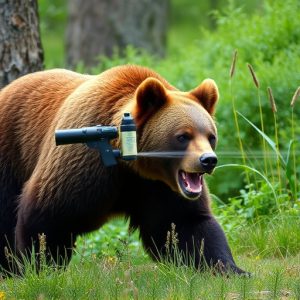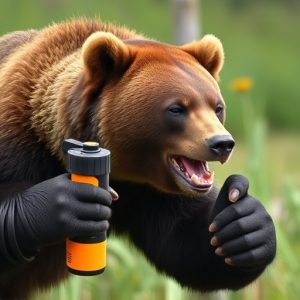Hiking Alaska’s Bear Country: Gear & Strategies for Safety
Hiking in Alaska's wilderness requires understanding bear behavior, especially grizzlies (brown…….
Hiking in Alaska's wilderness requires understanding bear behavior, especially grizzlies (brown bears). While bear spray is commonly used, its effectiveness against charging grizzlies is limited due to factors like wind and desensitization. In close-quarters attacks, physical defense with hiking poles or specialized gear like bear shields becomes crucial. For navigating grizzly habitats, consider higher capsaicin content sprays and robust hiking gear for enhanced safety during unexpected charges.
Hiking in Alaska’s stunning landscapes comes with a unique set of challenges, especially when sharing trails with bears. This guide delves into the essential gear and knowledge needed for safe exploration. We explore the effectiveness of bear spray, examining its role as a repellent and its limitations against aggressive charges from grizzlies. Understanding bear behavior is key; learn how to navigate potential risks and equip yourself with the right tools for hiking in Alaska’s captivating, yet wild, bear country.
- Understanding Bear Behavior and Potential Risks While Hiking in Alaska
- The Role of Bear Spray: Effective Repellent or Misconceived Weapon?
- Charging Grizzlies: When Spray Isn't Enough and Why Physical Defense Matters
- Comprehensive Gear Guide for Hiking Safely in Bear Country, Alaska
Understanding Bear Behavior and Potential Risks While Hiking in Alaska
Hiking in Alaska’s stunning wilderness comes with an inherent risk—the possibility of encountering bears. Understanding bear behavior is crucial for any hiker venturing into these regions, especially when navigating through habitats where grizzlies roam. While all bears possess defensive mechanisms, grizzly bears (or brown bears) are known for their aggression and powerful charging abilities.
Bear spray has long been considered a primary defense mechanism against these formidable creatures. However, it’s essential to note that the effectiveness of bear spray varies based on distance, wind conditions, and bear behavior. When faced with a charging grizzly, spray may not always deter the attack, making it crucial for hikers to maintain awareness, make loud noises, and consider carrying more robust protection, like an air-powered bear repellent gun, as a last resort.
The Role of Bear Spray: Effective Repellent or Misconceived Weapon?
Bear spray, often touted as an essential item for hiking in bear country, has sparked debates among outdoor enthusiasts and experts. The claim that it’s a reliable deterrent against charging grizzlies is not entirely true when examined closely. While bear spray can be effective at creating a barrier of irritants, it doesn’t guarantee safety in every scenario. A study by researchers shows that bears can still charge even when sprayed, especially brown bears known for their aggressive nature.
The perception of bear spray as a weapon may be misleading. It’s not designed to harm but rather to disable or discourage an attack. When used correctly—at close range and directly in the face—bear spray can provide crucial seconds to escape. However, factors like wind direction, distance, and bear behavior play significant roles in its effectiveness, leaving room for misjudgments that could have severe consequences in remote hiking areas.
Charging Grizzlies: When Spray Isn't Enough and Why Physical Defense Matters
In many outdoor encounters, bear spray is often the go-to defense mechanism against charging grizzlies. However, it’s crucial to understand its limitations and when physical defense might be a more effective strategy. Bear spray, while powerful and easy to use, has a short range and requires proper application techniques. It’s less effective at close range or in high wind conditions, leaving hikers vulnerable during a direct attack. Moreover, grizzlies can become desensitized to the scent of bear spray after repeated exposure, rendering it useless.
In such situations, physical defense becomes a vital alternative. This includes using hiking poles for parry and deflecting attacks, or carrying and mastering a bear shield or baton for protection against claws and teeth. These methods offer a greater line of defense during an unexpected charge, providing hikers with a more robust survival strategy in the Alaskan wilderness.
Comprehensive Gear Guide for Hiking Safely in Bear Country, Alaska
Hiking in Alaska’s beautiful but bear-infested wilderness requires careful preparation and the right gear to ensure a safe and enjoyable experience. This comprehensive guide focuses on essential items for navigating bear country, with a specific focus on the difference between traditional bear spray and its effectiveness against charging grizzlies.
Bear spray is a popular choice among hikers and outdoor enthusiasts in Alaska. It’s designed to deter bears when sprayed directly into the animal’s face during an encounter. However, it’s crucial to understand that not all bear spray is created equal. For grizzly bears, often larger and more aggressive than black bears, specialized bear spray with a higher concentration of capsaicin (the active ingredient) is recommended. When facing a charging grizzly, bear spray might not always be effective due to the animal’s size and behavior. In such cases, sturdy hiking gear like a robust cane or staff can provide an additional layer of protection.
When hiking in Alaska’s captivating yet potentially dangerous bear country, a combination of knowledge about bear behavior and the right gear is essential. While bear spray serves as a valuable tool against most encounters, understanding when it might not be enough, like when facing a charging grizzly, is crucial. Equipping yourself with robust hiking gear tailored to Alaskan conditions and bearing in mind the unique challenges presented by these majestic creatures can significantly enhance your safety. Remember, being prepared for any scenario ensures a more enjoyable and secure outdoor adventure.


